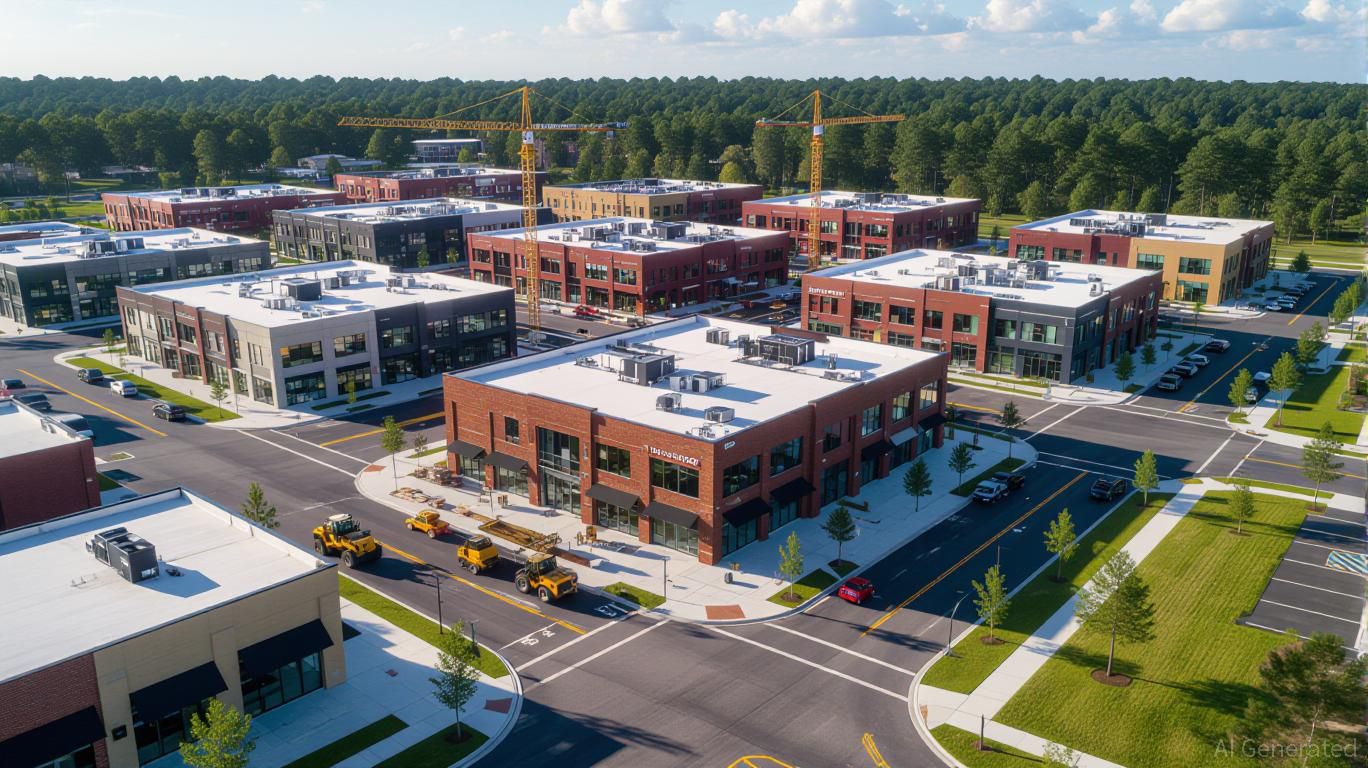ZK Atlas Enhancement: Driving Institutional Embrace Amid the Blockchain Scalability Competition
- ZKsync's Atlas Upgrade solves throughput bottlenecks with Airbender RISC-V zkVM, enabling 15,000+ TPS at $0.0001 per transaction. - Modular ZKsync OS reduces gas fees by 70% since 2023, enabling real-time financial applications while maintaining regulatory compliance. - Deutsche Bank and UBS test ZKsync for asset tokenization, highlighting its institutional appeal through privacy-preserving ZK features and sub-second finality. - Upcoming Fusaka upgrade aims to push TPS to 30,000 by December 2025, but reg
ZKsync Atlas Upgrade: Transforming Institutional Blockchain Adoption

The blockchain sector has consistently faced the challenge of achieving a balance between security, decentralization, and scalability. In 2025, the ZKsync Atlas Upgrade emerges as a game-changing development, setting new standards for both technology and economics within Ethereum Layer 2 (L2) solutions. By introducing the Airbender RISC-V zkVM and a modular ZKsync operating system, this upgrade not only overcomes throughput limitations but also meets the rigorous compliance and performance requirements of institutional users. This overview examines how Atlas's advancements could drive a new wave of institutional engagement in L2 solutions, fundamentally altering the blockchain infrastructure landscape.
Breakthrough Technology: Airbender zkVM and Modular OS
At the heart of the Atlas Upgrade is the Airbender RISC-V zkVM, which delivers over 15,000 transactions per second at a cost of just $0.0001 per transaction. This marks a significant improvement over traditional optimistic rollups like Arbitrum and Optimism, which depend on delayed finality for fraud detection. By compiling execution to RISC-V for proof generation, Airbender removes the risk of inconsistent logic between execution and verification, thereby boosting both security and efficiency.
Supporting this is the modular ZKsync OS, which has cut gas fees by 70% since 2023. This dramatic reduction is crucial for institutions aiming to launch real-time financial services, such as instant asset settlements or high-frequency trading. The modular design also empowers organizations to create private or semi-public Ethereum-linked chains while upholding regulatory standards and transparency. Notably, major banks like Deutsche Bank and UBS have already piloted ZKsync's infrastructure for asset tokenization, benefiting from its privacy-centric zero-knowledge features.

Driving Institutional Adoption: Compliance, Liquidity, and Instant Settlement
Historically, institutions have been reluctant to embrace blockchain due to hurdles such as regulatory uncertainty, fragmented liquidity, and inadequate performance. The Atlas Upgrade directly tackles these issues:
- Regulatory Alignment: The ZK Stack bridges liquidity between Ethereum's mainnet and Layer 2, minimizing fragmentation and enabling rapid cross-layer transactions. This is especially beneficial for institutions navigating complex regulatory landscapes, as it ensures smooth asset transfers with full auditability. ZKsync's governance—comprising the Token Assembly, Security Council, and Guardians—adds further protection against centralized control, a key concern for traditional finance.
- Real-Time Settlement: The upgrade introduces a next-generation sequencer capable of handling 25,000–30,000 transactions per second with near-instant finality. This is vital for applications that demand immediate transaction confirmation. For instance, Deutsche Bank's exploration of ZKsync for real-time asset tokenization highlights the platform's potential to replace outdated systems with lengthy settlement times.
- Enterprise-Ready Infrastructure: ZKsync enables the deployment of private chains with zero-knowledge privacy, making it highly attractive for regulated industries. Organizations can now implement blockchain solutions without exposing sensitive information, meeting the needs of sectors like healthcare and supply chain management.
ZKsync vs. Optimism and Arbitrum: A Comparative Perspective
Although Optimism and Arbitrum are well-established in the L2 ecosystem, the Atlas Upgrade positions ZKsync as the preferred choice for institutions that value high throughput and rapid finality. By late 2025, ZKsync boasts over 15,000 transactions per second with one-second finality, surpassing Optimism's and Arbitrum's daily transaction volumes. However, the latter platforms still offer advantages in developer tools and compatibility.
Governance models also set these platforms apart. ZKsync's multi-faceted governance structure offers a more decentralized approach compared to Optimism's token-based system, which may appeal to risk-conscious institutions. Meanwhile, Arbitrum's optimistic rollup, while developer-friendly, continues to lag in finality due to its reliance on challenge periods.
Looking Ahead: Fusaka Upgrade and Regulatory Challenges
The Atlas Upgrade is just one step in ZKsync's ongoing evolution. The forthcoming Fusaka upgrade, scheduled for December 2025, aims to increase throughput to 30,000 TPS while addressing interoperability and regulatory complexities. This progression signals ZKsync's ambition to become a foundational provider for institutional blockchain infrastructure.
Nevertheless, regulatory ambiguity remains a significant variable. While ZKsync's compliance-oriented design reduces certain risks, global regulatory bodies are still developing frameworks for tokenized assets and cross-border transactions. Institutions leveraging ZKsync must stay alert to shifting legal requirements, especially in regions like the EU and the United States.
Investment Perspective
For investors, the Atlas Upgrade represents a convergence of technological progress and growing institutional interest. The increasing total value locked in ZKsync's ecosystem reflects rising confidence in its capabilities. The upgrade's emphasis on instant settlement and regulatory compliance aligns with broader trends such as asset digitization and the demand for faster financial systems.
In comparison, Optimism and Arbitrum's dependence on optimistic rollups may limit their appeal to institutions that prioritize speed and certainty. While these platforms are likely to retain their user communities, ZKsync's technological advantages could enable it to capture a larger share of the institutional market, particularly in banking and asset tokenization.
Summary
The ZK Atlas Upgrade marks a pivotal moment for institutional blockchain adoption. By overcoming challenges related to scalability, compliance, and performance, ZKsync has established itself as a credible alternative to conventional financial infrastructure. As future upgrades like Fusaka roll out, the platform's ability to adapt to regulatory and technological changes will be key to its sustained leadership in the Layer 2 arena. For investors and institutions alike, ZKsync's advancements are not only redefining scalability but also shaping the future of blockchain in the enterprise world.
Disclaimer: The content of this article solely reflects the author's opinion and does not represent the platform in any capacity. This article is not intended to serve as a reference for making investment decisions.
You may also like
Governments Turn to Cryptocurrency as a Practical Defense Against Inflation and Currency Instability
- Bolivia integrates stablecoins into its financial system to combat 22% inflation, ranking 46th globally in crypto adoption after reversing a prior ban. - Regional efforts include Mexico's 314-petaflop AI supercomputer and Brazil's KuCoin-Pix integration, reflecting Latin America's crypto-driven economic strategies. - UAE's Abu Dhabi approves Ripple's RLUSD for institutional use, while Dubai's regulatory advances position the Middle East as a crypto infrastructure hub. - Challenges persist, including Boli
Ethereum News Update: Large Investors Anticipate ETH and ADA Recovery While Individual Traders Remain Cautious
- Crypto whales increasingly accumulate Ethereum (ETH) and Cardano (ADA) as retail investors withdraw amid market volatility, per on-chain analytics. - Ethereum's institutional accumulation hits records, with 21 million ETH held in large wallets, while Binance's exchange reserves shrink to 3.764 million ETH. - Cardano's recent chain-split incident exposed technical vulnerabilities, yet the network stabilized within 24 hours, prompting post-mortem analysis and treasury loans for ecosystem growth. - Ethereum
Institutions and Infrastructure: Why 2026 Marks the Year Crypto Comes of Age
- Crypto market enters 2026 maturation phase with altcoins and institutional adoption driving growth through presales and $75M+ DeFi fund investments. - Projects like Mutuum Finance ($19M raised) and RLUSD stablecoin highlight infrastructure upgrades and regulatory clarity accelerating institutional participation. - Abu Dhabi's Ripple approval and Nasdaq's Bitcoin ETF expansion signal crypto's integration into traditional finance, despite persistent security risks like Upbit's $36M breach. - 2026 trends pr
The Economic and Infrastructure Boom in Webster, NY: Reasons Investors Should Pay Attention to the Xerox Campus Redevelopment
- Webster , NY's Xerox campus is undergoing a $9.8M infrastructure overhaul via FAST NY grants, repositioning the town as a high-growth industrial hub. - Strategic upgrades to roads, utilities , and mixed-use developments are attracting advanced manufacturing, food processing, and real estate investment. - Median home prices rose 10.1% annually by 2025, driven by improved connectivity and state-backed revitalization projects like the 600 Ridge Road site. - A 2026 timeline for completed infrastructure and m
